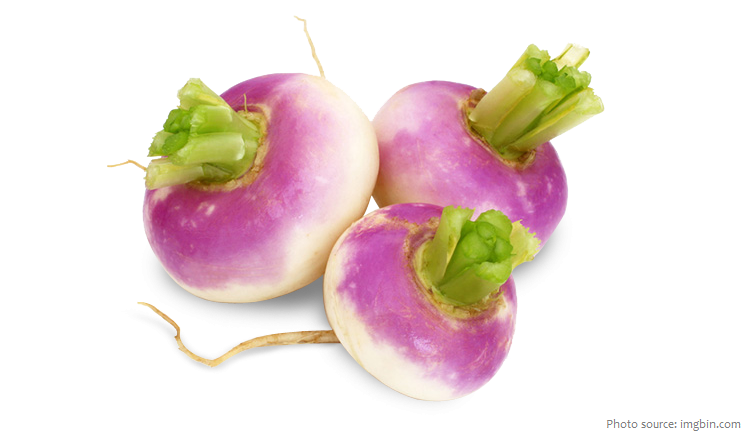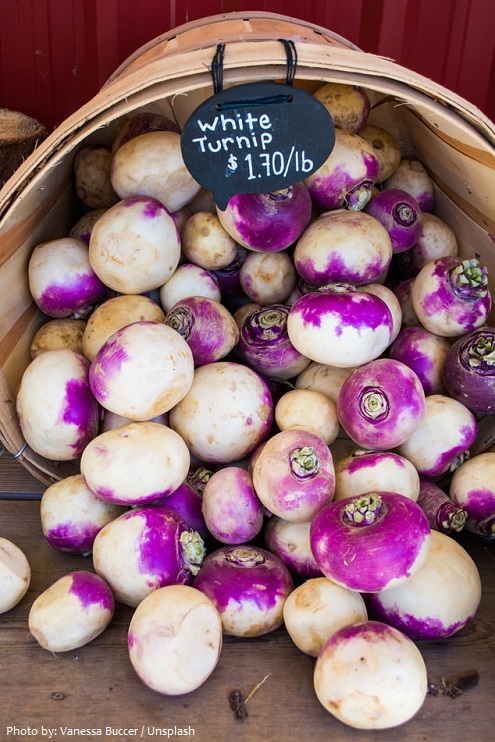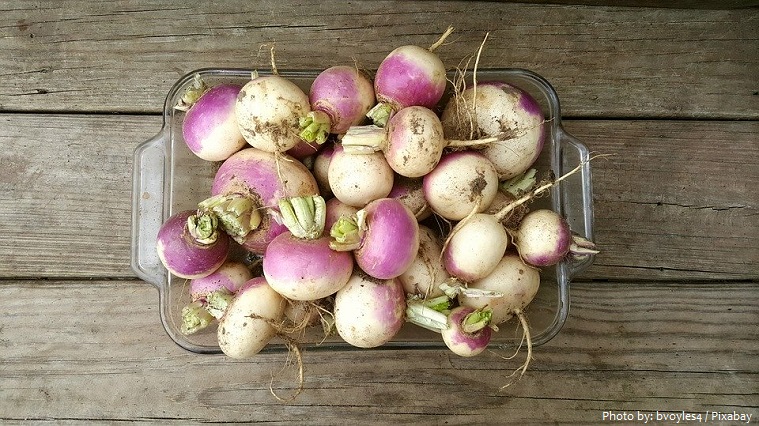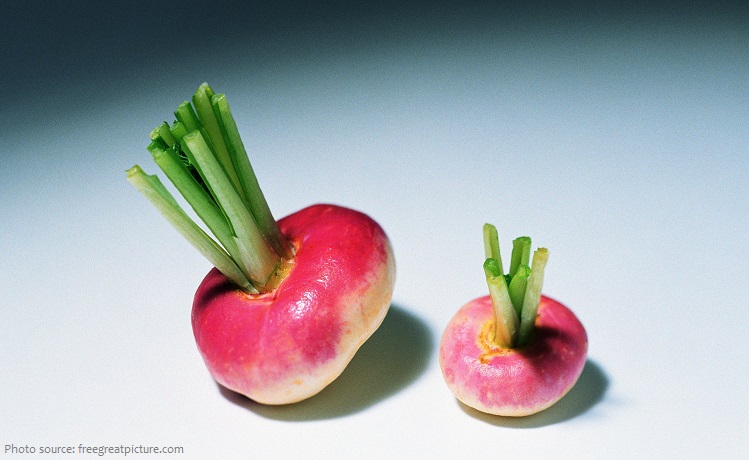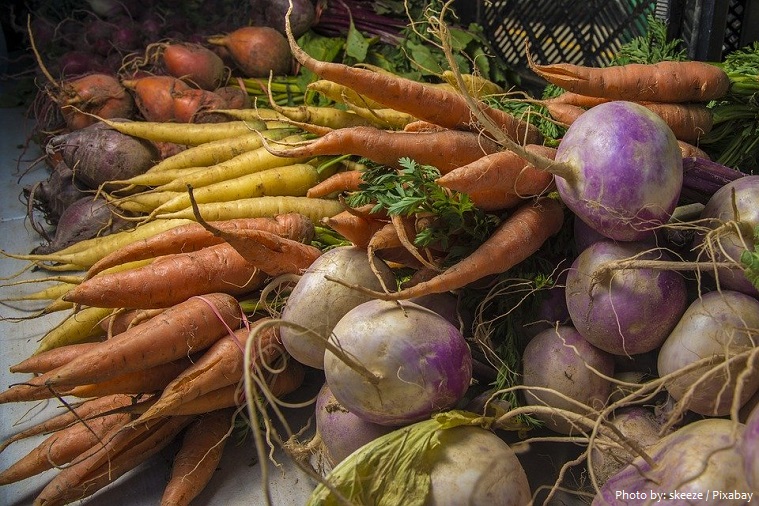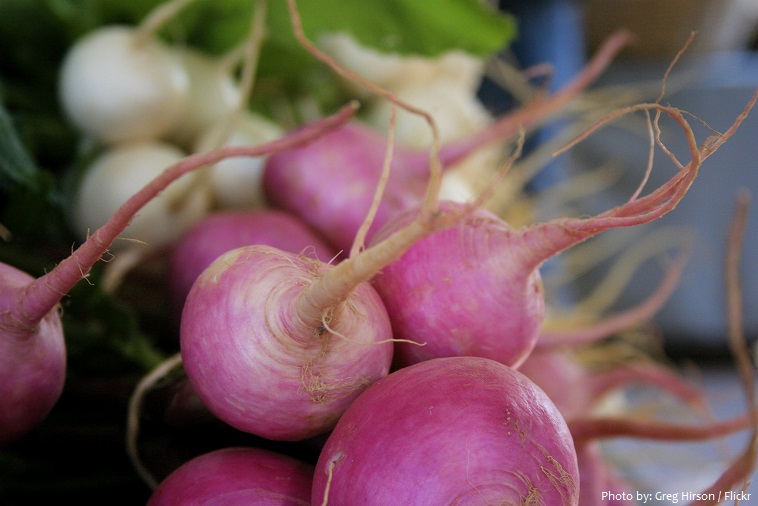The turnip or white turnip is a root vegetable.
It is commonly grown in temperate climates worldwide for its white, fleshy taproot.
There are over 30 varieties of turnips which differ in size, color, flavor and usage. Purple-top turnips are the most common type.
Smaller kinds of turnip are grown for human food. Larger ones are grown to feed livestock.
The most common type of turnip is mostly white-skinned apart from the upper part which protrude above the ground and are purple or red or greenish where the sun has hit.
The turnip is a hardy biennial plant in the mustard family.
The root is roughly globular, from 5 to 20 centimetres (2 to 8 in) in diameter, and lacks side roots. Turnip roots weigh up to 1 kilogram (2.2 lb), although they are usually harvested when smaller.
The heaviest turnip weighed 17.7 kg (39 lb 3 oz) and was grown by Scott and Mardie Robb (both USA) who presented it the Alaska State Fair, Palmer, USA on 1 September 2004.
Turnip leaves are sometimes eaten as “turnip greens” (“turnip tops” in the UK), and they resemble mustard greens (to which they are closely related) in flavor.
The turnip is a cool-season crop but does not require a long growing season. In mild climates, turnips are sown either in early spring or in late summer and develop rapidly enough to produce a crop before extremes of summer or late fall weather occur.
Young turnip roots are eaten raw in salads or pickled, they are also cooked and served whole or mashed and are used in stews.
Turnip greens are a common side dish in southeastern U.S. cooking, primarily during late fall and winter.
Turnip roots are excellent source of dietary fiber, vitamin C and vitamin B6, folate, calcium, potassium, and copper.
The greens are an excellent source of vitamins A and C, as well as a good source of calcium, iron, and riboflavin.
Some evidence shows the turnip was domesticated before the 15th century BC; it was grown in India at this time for its oil-bearing seeds.
The turnip was a well-established crop in Hellenistic and Roman times, which leads to the assumption that it was brought into cultivation earlier.
In Roman times, the turnip was the weapon of choice to hurl at unpopular public figures.
Pliny the Elder writes that he considered the turnip one of the most important vegetables of his day, stating “it should be spoken of immediately after corn, or the bean, at all events; for next to these two productions, there is no plant that is of more extensive use.”
The turnip was introduced into Britain from France by the Romans, and into North America by the early European settlers in the 17th century.
In the 15th century, “turnip eater” was the common term for a country bumpkin, and in Charles Dickens’s novels, if you called someone a “turnip,” you meant that he or she was a perfect idiot.
In the miserable Turnip Winter of World War I, German civilians—due to a failed potato harvest and bread shortages—were reduced to living almost wholly on turnips, a situation which pleased no one, despite the bolstering publication of a helpful cookbook titled “Turnips Instead of Potatoes.”
Faced with food shortages during World War II, British citizens also reluctantly turned to turnips. The crowning glory of wartime turnip cuisine was Woolton Pie, a dish invented by François Latry, master chef at London’s Savoy Hotel, and named for Lord Woolton, head of the Ministry of Food.
In most of England, the smaller white vegetables are called turnips, while the larger yellow ones are referred to as swedes.
In the United States, turnips are the same, but swedes are usually called rutabagas.
Turnips are carved out as lanterns for Halloween festivals in Ireland and Scotland.
